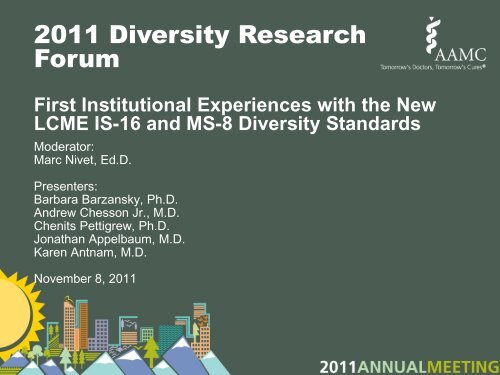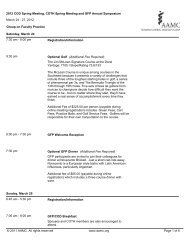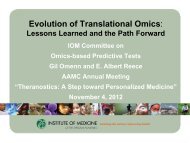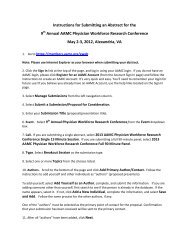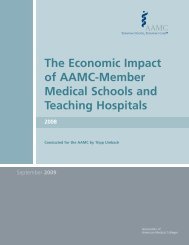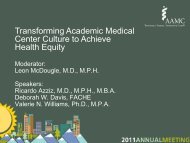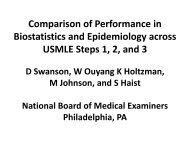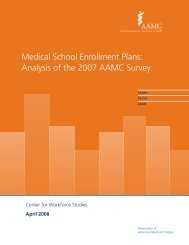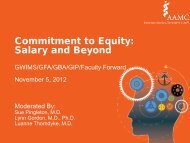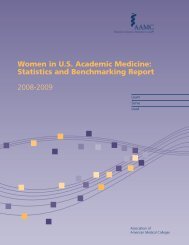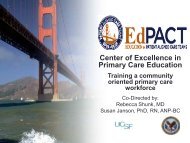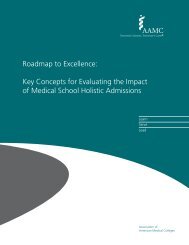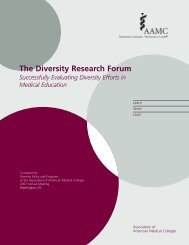First Institutional Experiences with the New LCME IS-16 and MS-8 ...
First Institutional Experiences with the New LCME IS-16 and MS-8 ...
First Institutional Experiences with the New LCME IS-16 and MS-8 ...
- No tags were found...
Create successful ePaper yourself
Turn your PDF publications into a flip-book with our unique Google optimized e-Paper software.
2011 Diversity ResearchForum<strong>First</strong> <strong>Institutional</strong> <strong>Experiences</strong> <strong>with</strong> <strong>the</strong> <strong>New</strong><strong>LCME</strong> <strong>IS</strong>-<strong>16</strong> <strong>and</strong> <strong>MS</strong>-8 Diversity St<strong>and</strong>ardsModerator:Marc Nivet, Ed.D.Presenters:Barbara Barzansky, Ph.D.Andrew Chesson Jr., M.D.Chenits Pettigrew, Ph.D.Jonathan Appelbaum, M.D.Karen Antnam, M.D.November 8, 2011
The History <strong>and</strong> Application of<strong>the</strong> <strong>LCME</strong>’s Diversity St<strong>and</strong>ardsBarbara Barzansky, PhD, MHPE<strong>LCME</strong> Co-Secretary
Goals of <strong>the</strong> Presentation Describe <strong>the</strong> history of st<strong>and</strong>ards <strong>IS</strong>-<strong>16</strong>(institutional diversity) <strong>and</strong> <strong>MS</strong>-8 (“pipeline”programs to broaden diversity) Summarize <strong>the</strong> expectations of <strong>the</strong> st<strong>and</strong>ards Describe <strong>the</strong> main reasons for citations ofnoncompliance
Previous St<strong>and</strong>ards<strong>MS</strong>-8: Each medical school should havepolicies <strong>and</strong> practices ensuring <strong>the</strong> gender,racial, cultural, <strong>and</strong> economic diversity of itsstudents.FA-1: The recruitment <strong>and</strong> development of amedical school’s faculty should take intoaccount its mission, <strong>the</strong> diversity of its studentbody, <strong>and</strong> <strong>the</strong> population that its serves.
Basis for <strong>the</strong> ChangeSt<strong>and</strong>ard <strong>IS</strong>-<strong>16</strong> was informed by severalsources: Supreme Court decisions 2008 AAMC document Roadmap to Diversity Input from a broad-based advisory group<strong>New</strong> st<strong>and</strong>ard <strong>MS</strong>-8 was based on <strong>the</strong>expectations of <strong>the</strong> previous <strong>MS</strong>-8 (MedicalStudent Diversity)
<strong>New</strong> St<strong>and</strong>ards<strong>IS</strong>-<strong>16</strong>. An institution that offers a medicaleducation program must have policies <strong>and</strong>practices to achieve appropriate diversityamong its students, faculty, staff <strong>and</strong> o<strong>the</strong>rmembers of its academic community, <strong>and</strong>must engage in ongoing, systematic, <strong>and</strong>focused efforts to attract <strong>and</strong> retain students,faculty, staff, <strong>and</strong> o<strong>the</strong>rs from demographicallydiverse backgrounds.
<strong>New</strong> St<strong>and</strong>ards (con’t)<strong>MS</strong>-8. A medical education program mustdevelop programs or partnerships aimed atbroadening diversity among qualifiedapplicants for medical school admission.
Attention to diversity is now anexpectation for an institution Need for focused, significant, <strong>and</strong> sustainedefforts (from annotation to <strong>IS</strong>-<strong>16</strong>) <strong>Institutional</strong> policies related to diversity are putinto effect in:- student recruitment, selection, retention- financial aid- <strong>the</strong> educational program (e.g., culturalcompetence)- faculty/ staff recruitment, employment,retention- faculty development- liaison <strong>with</strong> <strong>the</strong> community (e.g., servicelearning)
Schools share responsibility to exp<strong>and</strong><strong>the</strong> pool of diverse applicantsA medical school should work <strong>with</strong>in its owninstitution or collaborate <strong>with</strong> o<strong>the</strong>rs to makeadmission more accessible:- Pipeline programs- Collaboration <strong>with</strong> institutions that servestudents from disadvantaged backgrounds- Community service activities that heightenawareness of medicine as a career- Academic enrichment programs(From annotation to <strong>MS</strong>-8)Need to document <strong>the</strong> results
Leading Causes of Noncompliance Failure to codify diversity in institutionalpolicies- at <strong>the</strong> medical school level, preferably; couldbe at <strong>the</strong> university level Failure to define categories for students,faculty, <strong>and</strong> staff that “add value” to <strong>the</strong>learning environment Failure to document that <strong>the</strong>re are programs toenhance diversity in place <strong>and</strong> resources tosupport <strong>the</strong>se programs
Diversity ResearchForum2011 AAMCAnnual meetingAndrew L. Chesson, Jr., M.D.Dean, School of Medicine LSU Health SciencesCenterShreveport, Louisiana
A Case Presentation:Ga<strong>the</strong>ring evidence to meet <strong>the</strong>diversity st<strong>and</strong>ardsThis 37 year old medical schoolpresents <strong>with</strong> a CC of needing toobtain clarification concerningdiversity accreditationst<strong>and</strong>ards…
About Us - (PMHx)North Louisiana physicians <strong>and</strong>community leaders worked <strong>with</strong> arealegislators to:• develop a second state-supported SOM• provide more opportunity for Louisianacitizens to enter <strong>the</strong> healthcare field• train more physicians for Louisiana(especially for rural <strong>and</strong> underservedareas of <strong>the</strong> state)
AND…• continue <strong>the</strong> long Louisianatradition for providing healthcare forits citizens (our hospital had beenserving that mission in Shreveportsince 1886 , when it was founded toprovide healthcare for “newly freedpeople of color <strong>and</strong> <strong>the</strong> returningconfederate veterans”)
Social History
Medical Students – (Physicalexam)• We only accept Louisiana residents• Class size: 100 to 118 over 7 years• GPA: 3.63 – 3.73 (3.6 – 3.7)• MCAT: 27.5 – 29 (30.3 – 31.1)• Low tuition: $12,000 to $13,500
Curriculum Strengths• Tremendous clinical experiences, relatedteaching pathology, <strong>and</strong> considerable timeinteracting <strong>with</strong> patients as <strong>the</strong>ir teachersstarting from <strong>the</strong> first week of <strong>the</strong>ircurriculum• Despite entering students <strong>with</strong> less thannational average MCAT scores, at <strong>the</strong> end of<strong>the</strong> curriculum, <strong>the</strong>y are at or above thatnational average in USMLE Parts 1, 2 <strong>and</strong> 3pass rate.
Some Diversity Challenges• Despite several HBCs in Louisiana<strong>with</strong> a high quality of many of <strong>the</strong>irgraduates, one cannot qualify forstate residency while attendingschool• Hopwood vs. State of Texas [5 thCircuit - 5 state region (Texas,Oklahoma, Louisiana, Arkansas <strong>and</strong><strong>New</strong> Mexico)]
What brought us to ourpart in <strong>the</strong> DiversityResearch Forumpanel?(Laboratory <strong>and</strong> x-ray results)
Last Full <strong>LCME</strong> Visit – Jan. 2006<strong>IS</strong>-<strong>16</strong>Areas of “partial or substantialnoncompliance”• <strong>IS</strong>-14 (more research opportunities)• FA-2 (Derm currently a single memberdepartment)• FA-1 “Disparity between <strong>the</strong> regionalpopulation composition <strong>and</strong> <strong>the</strong> student<strong>and</strong> faculty composition”
• The “pipeline” program is injeopardy due to impending nationalTitle VII funding cuts to all schoolsRecommendation: report on <strong>the</strong>above issues in 2 years
Our 2007 Report to <strong>LCME</strong>Faculty diversity:• Katrina <strong>and</strong> Rita made this a challengingtime to recruit any faculty to Louisiana or toclarify any population demographics• The LSU System Diversity Initiative by BOS• Active faculty recruitment is ongoing• Student diversity charts <strong>and</strong> tables supplied
• Loss of HCOP/Title 7 Funding did occur– Majority of <strong>the</strong> successful program K-20 wasmaintained <strong>with</strong> medical center clinical fundingwhile exploring o<strong>the</strong>r options to keep this 18year old pipeline intact• Developing more rural <strong>and</strong> underservedcomponents <strong>and</strong> ga<strong>the</strong>ring data on thosesuccesses (AHEC, Pipeline, 70% of <strong>the</strong>physicians in <strong>the</strong> north half of <strong>the</strong> state areLSUHSC grads)
UNDERGRADUATERESEARCHAPPRENTICESHIPPROGRAMEDUCATIONALFAMILIARIZATIONPROGRAMJUMPSTARTSUMMERENRICHMENTPROGRAMComputer LabToursPoster SessionsResearchPRE-MATRICULATIONENRICHMENTPROGRAMOil City ElementarySCIENCEACADEMYShreve Isl<strong>and</strong> ElementaryLOU<strong>IS</strong>IANA STATEPREPARATORYPROGRAM<strong>New</strong>ton Smith ElementaryLakeshore ElementaryLouisiana State University Health Sciences Center - Shreveport – Making a Differencewww.lsuhscshreveport.edu/MulticulturalAffairs
Reply from <strong>LCME</strong>• Student diversity is not fullyresolved <strong>and</strong> a 2 year report is due• Added reporting: Due to <strong>the</strong>irconcerns related to state financialinstability, post hurricanes, willneed reporting
Our 2009 Report to <strong>LCME</strong>Student Diversity• Partnership in science educationpipeline <strong>with</strong> fewer total students butmaintained key bridge components, <strong>with</strong>most now supported by LSUHSCinternal funding plus additionalpartnerships added <strong>with</strong> local schoolboards, SciPort Science Center, LSU-Shreveport, etc., were developed
• Financial stability report:verification that no negativeimpact on our medical schooleducation program from <strong>the</strong>post hurricane issues
2009 Reply from <strong>LCME</strong>• Medical school diversity “remainsin transition” <strong>and</strong> a report is due in2011
Our 2011 Report to <strong>LCME</strong>*NOTE: <strong>LCME</strong>’s change to <strong>IS</strong>-<strong>16</strong> for new sitevisits occurred in this interval• Health Sciences Center refilled ourDirector of Diversity Affairs/EEO• OMA worked <strong>with</strong> SA to have us becomea field test <strong>and</strong> beta site for <strong>the</strong> “roadmap to excellence through diversity”(admission workshop – holistic review,initiated restructuring of admissionsmembers, etc.)
•AHEC expansion to college, pre-college,plus even more first year rotations <strong>and</strong> 3 rdyear family practice AHEC-relatedrotations•LSU System Diversity Task Forceproduced 3 System-wide white papers; 1)improving campus climates, 2)recruitment <strong>and</strong> retention of diversestudents <strong>and</strong> 3) education <strong>and</strong> training ofLSU campus employees
2011 From <strong>LCME</strong>The area in transition regardingstudent diversity has been partiallyresolved but “had not yet yielded <strong>the</strong>intended results” <strong>the</strong>refore, during<strong>the</strong> full survey visit, 2013-2014, <strong>the</strong>survey team “will be requested toreview <strong>the</strong> School of Medicine’sprogress toward meeting its diversitygoals.”
Questions• What is <strong>the</strong> “intended” result from <strong>the</strong><strong>LCME</strong> perspective <strong>and</strong> what does itlook like so we can strive to achieve it?• How does that differ from meeting <strong>the</strong>School of Medicine’s identified diversitygoals (including legislature, statebudget, founding mission, legal issues,etc)?
<strong>MS</strong>8-<strong>IS</strong> <strong>16</strong> <strong>LCME</strong> PreparationDiversity Research ForumAAMC Annual MeetingChenits Pettigrew, Jr.Assistant Dean for Student Affairs <strong>and</strong>Director of Diversity ProgramsUniversity of Pittsburgh School of MedicineNovember 8, 2011
Discussion Points• University of Pittsburgh Historical Context1967-68• UPSOM Administrative <strong>and</strong> OperationalEnvironment• UPSOM Approach• <strong>LCME</strong> Preparation <strong>and</strong> Process• Successes <strong>and</strong> Challenges
Historical ContextUniversity of PittsburghSchool of MedicineStudent Affairs/Diversity Programs
The Foundation• 1967 Health Opportunities Program• 1968 14 Dem<strong>and</strong>s• 1968 AA Associate Provost(Intentionality/Professoriate)• 1968 UPSOM Reaffirms No Discrimination• 1972 Independent Office of Special Student Programsestablished• 1972 first AA Assistant Dean for Student Affairs <strong>and</strong>Director of Special Student Programs appointed(member of <strong>the</strong> Admissions Committee)University of PittsburghSchool of MedicineStudent Affairs/Diversity Programs
University of PittsburghSchool of MedicineStudent Affairs/Diversity ProgramsPartnerships
Our Environment (Key Players)UniversityPhysician InclusionCouncilUPSOMAssistant Dean forStudent Affairs <strong>and</strong>Director of DiversityProgramsUPMCAssistant ViceChancellor HealthSciences DiversitySenior ViceChancellor HealthSciences <strong>and</strong> DeanSOMChief DiversityOfficer UPMCVice Dean UPSOMUniversity of PittsburghSchool of MedicineStudent Affairs/Diversity Programs
Physician Inclusion Council• Co-Chairs Chairs of Ophthalmology <strong>and</strong> FamilyMedicine• Senior Associate Vice Chancellor of <strong>the</strong> HealthSciences <strong>and</strong> Special Assistant to CEO UPMC• Faculty, GME, Residents, Administrators• Initiatives (funded)University of PittsburghSchool of MedicineStudent Affairs/Diversity Programs
UPSOM Approach• Intentionality (commitment)• Framework• Definition• Audit/Assessment• Develop Initiatives <strong>with</strong> goals linked to <strong>the</strong>definition <strong>and</strong> audit• Surveillance• RealignmentUniversity of PittsburghSchool of MedicineStudent Affairs/Diversity Programs
<strong>LCME</strong> Preparation CycleWelcomed <strong>the</strong>OpportunityBullitt PointSummaryAudit AnalyzeAssessmentDrafts, Drafts,DraftsReview 2003(perfect score)SimulationsUPSOM <strong>LCME</strong>VetsReview <strong>the</strong><strong>LCME</strong> ProcessDeliberate <strong>and</strong>IntegrateReview <strong>and</strong>Study <strong>the</strong>St<strong>and</strong>ardsUniversity of PittsburghSchool of MedicineStudent Affairs/Diversity ProgramsID Successes<strong>and</strong>ChallengesAssignCommittees(reframed)
Successes <strong>and</strong> Challenges <strong>IS</strong> <strong>16</strong>• Reaccredited• Students (success)• Faculty, House Staff, Staff (challenge)Currently going through our <strong>LCME</strong> cycle todevelop response <strong>and</strong> to realign, redefine orredesign our efforts
Diversity Research Forum:<strong>LCME</strong> <strong>IS</strong>-<strong>16</strong> ExperienceJonathan S. Appelbaum, MD, FACPDirector, Internal Medicine EducationGDI RepresentativeChair, Diversity <strong>and</strong> Inclusion Council FSU College ofMedicineAAMC 2011 Denver, CO
The Florida State University College of Medicine will educate <strong>and</strong>develop exemplary physicians who practice patient-centered healthcare, discover <strong>and</strong> advance knowledge, <strong>and</strong> are responsive tocommunity needs, especially through service to elder, rural,minority, <strong>and</strong> underserved populations.
RuralElderlyMinorityMedically Underserved
History of FSU-COM• FSU-COM established June 2000 byFlorida legislature• Mission established by law• <strong>First</strong> graduation class 2005• <strong>First</strong> full <strong>LCME</strong> accreditation 2005• Reaccredited by <strong>LCME</strong> in 2011◦ Strengths included pipeline programs
Who We Are:Students, faculty <strong>and</strong> staff (percentage)Category<strong>First</strong>-YearStudentsAll Students Faculty Staff*(define)Black 9.2 10.2 6.4 13.5Hispanic 9.2 8.8 3.4 4.2AmericanIndian/AlaskaNative 1.7 0.8 0.9 0.0Asian 10.9 13.3 9.2 3.1
How Do We Meet <strong>the</strong> Mission?• Pipeline programs• Holistic admissions• Strong student support systems• Ambulatory training model---70% outside<strong>the</strong> hospital in <strong>the</strong> community setting• One-on-one instruction by communityphysicians beginning Year 1
Community-based TrainingAt <strong>the</strong> regional campuses, third- <strong>and</strong> fourth-year studentstrain one-on-one <strong>with</strong> practicing physicians in privatepractices, hospitals, <strong>and</strong> o<strong>the</strong>r medical facilities.
Outreach Programs-overviewProvide a career pathway for studentswho have been traditionallyunderrepresented in medical schoolOffered from middle school through <strong>the</strong>post-baccalaureate level
Pre-College Outreach ProgramsSSTRIDE (Science Student Toge<strong>the</strong>rReaching Instructional Diversity inEducation)In-school science electiveAfter-school tutoringH<strong>and</strong>s-on activities
College-Level Outreach ProgramsMCAT preparationProfessional skillsdevelopmentCertified Nurse TechTrainingPhysician shadowing
Bridge to Clinical Medicine• Created in 2001Program• Transition from post-baccalaureateprogram to <strong>MS</strong> program in 2009• 97% (35) students entering medicalschool from <strong>the</strong> Program have graduatedmedical school• 71.4% (20) of <strong>the</strong>se have entered primarycare
Outcomes from Outreach & Advising• 13.3% (126) ofFSUCOM students(2001-2011)havecome through <strong>the</strong>Outreach pipeline.• 12.0% (54) ofFSUCOM graduates(2005-2011) havecome through <strong>the</strong>Outreach pipeline.
Medical Student Outcomes34.2% of graduates (450) were from minoritybackgrounds6.9% of graduates were from rural communities55.0% of graduates matched in primary care residency66.7% completing GME are practicing in Florida18.0% completing GME are in rural communities
Boston University | Medical CampusBoston University School of MedicineKaren Antman, M.D.Provost, Medical CampusDean, School of MedicineBoston University Medical Campus
Our <strong>LCME</strong> report: <strong>IS</strong>-<strong>16</strong>Diversity is explicitly a goal in:Boston University• statement on diversity• faculty search manualMedical school• mission statement• 2006 <strong>and</strong> 2010 strategic plans• institutional learning objectives: behaving “in acaring, compassionate <strong>and</strong> sensitive manner towardpatients <strong>and</strong> colleagues of all cultures <strong>and</strong>backgrounds.”Boston University Medical Campus
Boston University1839: Methodist Seminary1869: Boston UniversityWilliam Warren, 1 stPresident, admitted bothgenders, all races &religions; study abroadprogramBoston University Medical Campus
Boston University1955 PhD in Theology:Dr. Martin Lu<strong>the</strong>r KingBoston University Medical Campus
Boston University Medical Campus1848 Boston Female Medical College1855 Boston City Hospital: 1 st US city hospital1873 Became BU School of Medicine: coed1963 Dental School1976 School of Public Health1996 Boston Medical Center + 14 Community Centers1997 BMC HealthNet Plan: 250,000 membersBoston University Medical Campus
BU School of Medicine1864 Rebecca LeeCrumpler, 1st blackwoman MD1890 Charles Eastman1st Native AmericanMD1897 Solomon CarterFull, 1 st blackpsychiatristBoston University Medical Campus
Boston University Medical Campus
Our <strong>LCME</strong> report: <strong>IS</strong>-<strong>16</strong>Definition• Boston University defines diversity broadly<strong>and</strong> includes “<strong>the</strong> constructs of lifeexperience, gender, sexual orientation, race,ethnicity, physical ability, spiritual beliefs,<strong>and</strong> intellectual approach”.• Problem re <strong>LCME</strong>: <strong>the</strong> st<strong>and</strong>ard wantsoutcomes on each.Boston University Medical Campus
Boston University Medical Campus
Our <strong>LCME</strong> report on <strong>IS</strong>-<strong>16</strong>RecruitmentFaculty <strong>and</strong> leadership searches followprocedures in <strong>the</strong> faculty search manualentitled, “Searching for Excellence <strong>and</strong>Diversity”•Develop a large pool of diverse c<strong>and</strong>idates•Avoid unconscious biasesBoston University Medical Campus
Our <strong>LCME</strong> report on <strong>IS</strong>-<strong>16</strong>Coordination• An ad hoc campus-wide Committee onDiversity <strong>and</strong> Health Disparities was formedin 2008, <strong>and</strong> <strong>the</strong> scope of <strong>the</strong> Office ofDiversity <strong>and</strong> Multicultural Affairs wasexp<strong>and</strong>ed.• We transitioned from an Office of MinorityAffairs to <strong>the</strong> Office of Diversity <strong>and</strong>Multicultural Affairs.Boston University Medical Campus
Our <strong>LCME</strong> report on <strong>IS</strong>-<strong>16</strong>:Admissions• Admissions mission statement specifiesdiversity.• Holistic review selects applicants for <strong>the</strong>ircontribution to diversity.• Robust faculty development programs prepareadmissions committee members in holisticreview.• Dean charges committee to maintain <strong>the</strong>institutional commitment to diversity.Boston University Medical Campus
Boston University Medical Campus
Boston University Medical Campus
Our <strong>LCME</strong> report on <strong>IS</strong>-<strong>16</strong>:Pipeline Programs• Several pipeline programsenhance diversity• Early Medical SchoolSelection Program datesfrom 1960s (Lou Sullivan)• Students from historicallyBlack, Hispanic colleges• 3 year enrichmentprogramBoston University Medical Campus
Our <strong>LCME</strong> report on <strong>IS</strong>-<strong>16</strong>:Financial Aid• Financial aid is need based• Disproportional amount of scholarship moneyawarded to students from groups underrepresentedin medicine.Boston University Medical Campus
Our <strong>LCME</strong> report on <strong>IS</strong>-<strong>16</strong>:Curriculum• The curriculum emphasizes issues relating to<strong>the</strong> care of diverse populations.• Experiential sessions enhanced by reflectiveexercises are placed throughout <strong>the</strong>preclerkship <strong>and</strong> clerkship curricula.Boston University Medical Campus
Our <strong>LCME</strong> report on <strong>IS</strong>-<strong>16</strong>:Community EngagementBUSM is fully engaged in <strong>the</strong> community via its:• Relationships <strong>with</strong> 11 community healthcenters,• Clinical trials that address health disparities<strong>and</strong> enroll community members• Pipeline programs for public school children.Boston University Medical Campus
Boston University Medical CenterBoston University Medical Campus
Q & ADr. Karen Antman, M.D.Provost of <strong>the</strong> Medical Campus <strong>and</strong> DeanBoston University School of MedicineJonathan Appelbaum, M.D.Associate Professor; Director, Internal Medicine EducationFlorida State University College of MedicineBarbara Barzansky, Ph.D.<strong>LCME</strong> Co-Secretary, Undergraduate Medical EducationLiaison Committee on Medicine EducationAndrew Chesson Jr., M.D.DeanSchool of Medicine, Louisiana State University Health Sciences Center-ShreveportChenits Pettigrew, Ph.D.Assistant Dean of Student Affairs <strong>and</strong> Director of Diversity ProgramsUniversity of Pittsburgh School of Medicine


